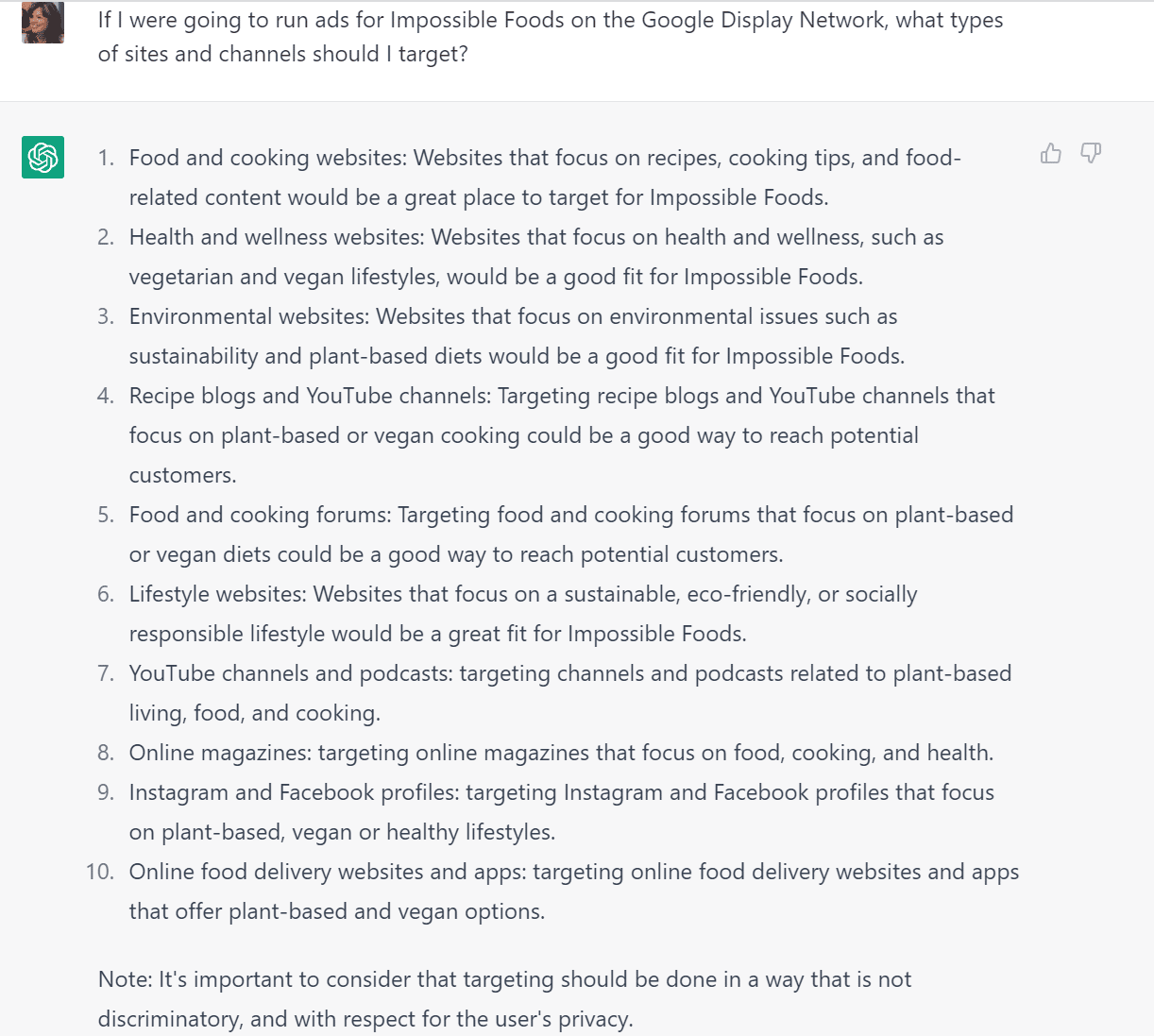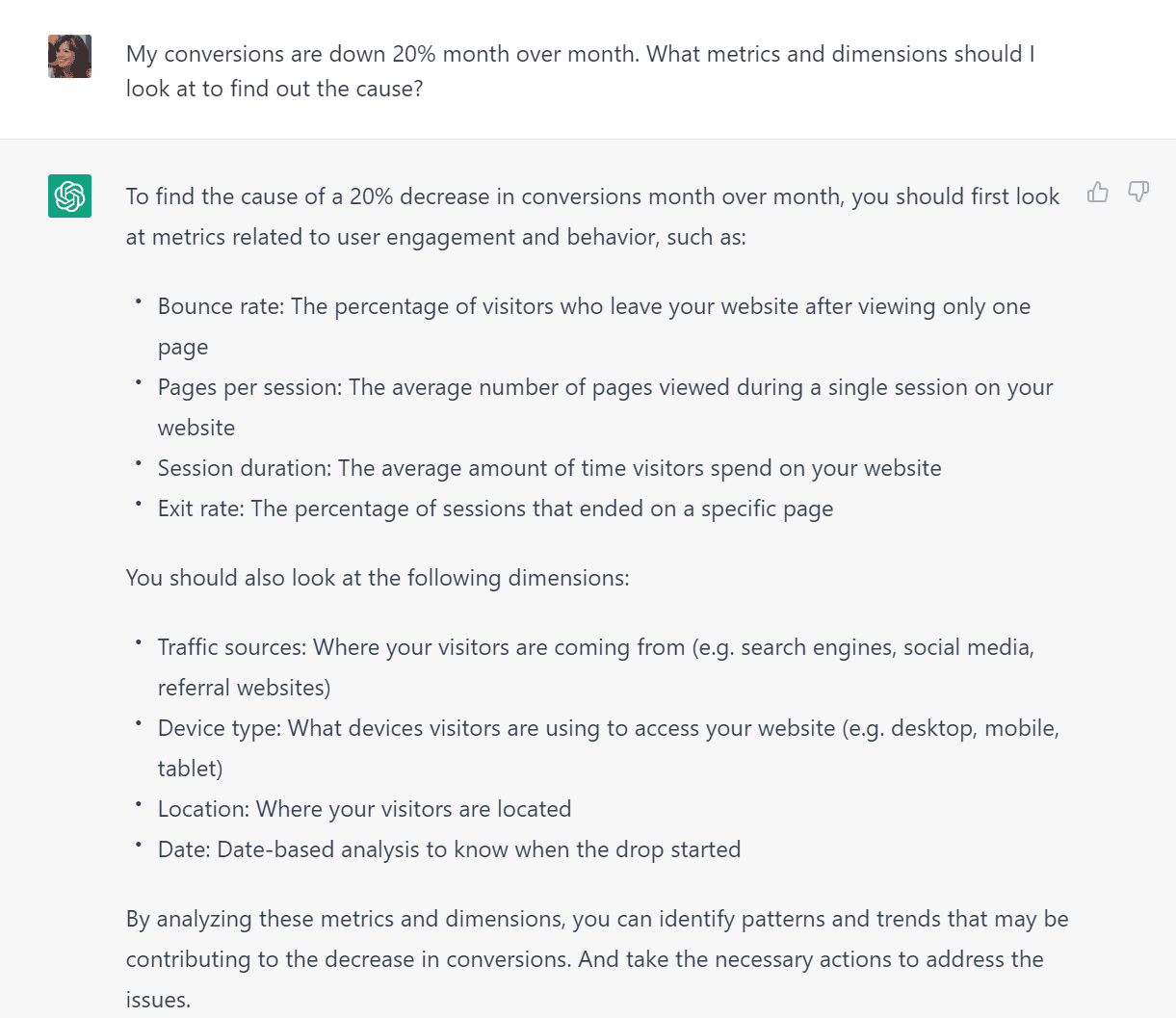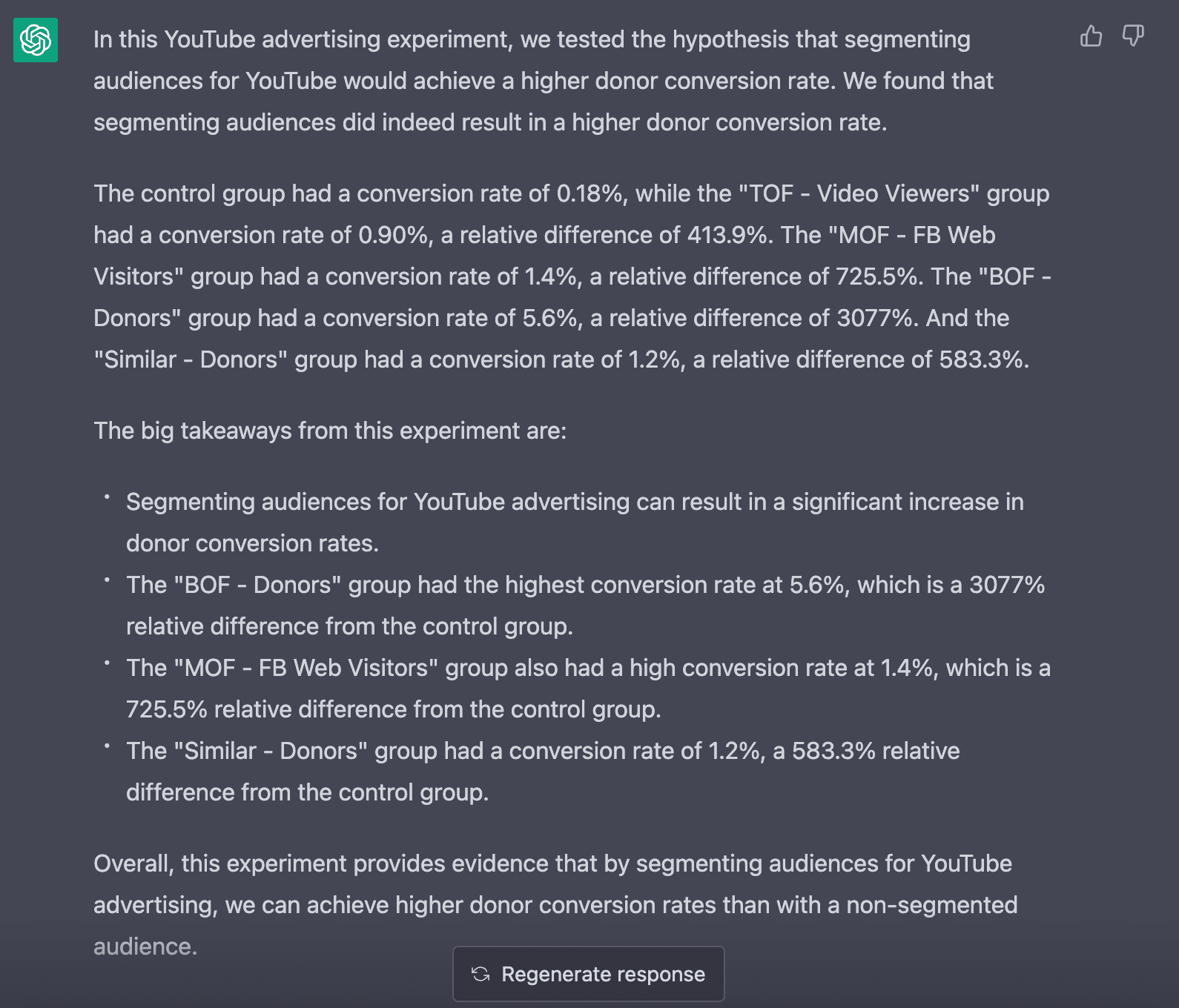Paid search marketers are no strangers to artificial intelligence. Every day, we use AI-powered platforms like ad engines, third-party management tools and copywriting software.
But there’s a new bot in town (you may have heard of it), and it’s not making the same old “control-for-automation” trade we’re used to.
Read on to see how you can use ChatGPT to level up your marketing game without sacrificing strategy, authenticity or creativity.
A quick primer on launching ChatGPT
If you haven’t logged into ChatGPT yet, no worries!
You’re a busy person, and much of what you’ve read so far has probably sounded like hype.
But take a minute to create an account to follow along and play in the sandbox yourself.
To get started, create your account at chat.openai.com. It’s completely free as of this writing, so you don’t need to worry about starting the clock on a limited-time trial or using up tokens on a learning curve.
Once you’re logged in, you’ll see a search-style box where you can enter some text, and that’s exactly what you’ll do next.
How ChatGPT prompts work
You probably know that ChatGPT can generate full movie scripts, thousands of headlines, or a year’s worth of social media posts.
You also know that AI tends to produce some pretty dumb results.
But you can control the quality of your responses (outputs) just by changing the quality of your prompts (inputs).
- Poor prompt: “Write a Google ad for my business.”
- Better prompt: “Write a Google ad for my business that sells organic skincare products to women looking for natural alternatives.”
- Great prompt: “Write a Google ad for my business that sells organic skincare products to women looking for natural alternatives, emphasizing the benefits of our all-natural ingredients and the satisfaction guarantee for first-time customers.”
The first prompt is generic and lacks any substance for ChatGPT to use. This is the embodiment of “garbage in, garbage out.”
The last example provides information like:
- Product details.
- Value proposition and key benefits.
- Risk-reversal element.
- Target market.
The prompt is clear, explicit and specific and will create a far better ad.
Here are 15 strategic prompts to inspire you, lighten your workload, and improve your results.
Create strategic ads and assets with ChatGPT
Writing ads at scale is table stakes for AI. Let’s ask ChatGPT to apply the same type of strategic thinking to your ads that you would use on your own.
Produce a viable A/B test for responsive search ads (RSAs)
What happens when we don’t just request ad variants but ask for the underlying methodology?
- Prompt 1: “Create two Google Ads in an RSA format (using multiple headlines and descriptions) for an A/B test for “Ms. Hvac’s HVACs.” Explain why the ads would make a good test.”

Here, ChatGPT did a great job explaining the merits of the test:
- Ad 1 is focused on providing reliable and efficient services.
- Ad 2 is focused on cost savings and energy efficiency.
It didn’t hit the target with the character count (it often doesn’t) or the number of description lines, but those are easy edits now that the bulk of the work has been done for you.
Let’s look at another example.
Get creative concepts for responsive display ads (RDAs)
In this prompt, I’m asking for a lot of creative consideration for some image-heavy ads.
- Prompt 2: “I need to create some responsive display ads for a Google Ads campaign. Please suggest images, headlines and descriptions for a meatless shepherd’s pie with spokesperson Paul McCartney. Lyric puns are acceptable.”
Not only did ChatGPT recommend compelling ideas for product shots and ad copy, but it also came up with this line: “The Vegetarian Way to Live and Let Pie.”
Bravo, ChatGPT. Bravo.
Optimize your landing pages
Are you a paid search marketer who doesn’t build landing pages? If so, you probably feel out of your depth giving feedback on them – even if the pages are hurting your ad performance.
Use these prompts to identify smart LP recommendations and share them with confidence.
- Prompt 3: “What can a person do from this page, and why would they want to do it? [LP URL]”
This is a quick-and-dirty way to evaluate whether the page content and call to action are appropriate for your prospects.
- Prompt 4: “I’m currently driving paid search traffic to this landing page [LP URL]. How would you suggest improving it so that we get a better conversion rate?”
This prompt may give you general LP advice rather than reviewing your actual URL, but the general advice is worth heeding.
- Prompt 5: “Rewrite a headline for [LP URL] that explains [unique value proposition] and includes the phrase [keyword phrase].”
Many landing page headlines are still catchy instead of clear. Use this prompt to create a better message-match sequence and stronger above-the-fold content.
We’ve looked at prompts for RSAs, RDAs and landing pages. Expand your ChatGPT skills further by enlisting its help for ad extensions, YouTube ad scripts and hooks, product feeds and other assets.
Unlock the power of AI-assisted research and planning
Do you ever ask a client for their key benefits and they come back with “we’ve been around for 30 years” and “our products are high quality?” No? Just me?
Either way, it just got much faster to get intel on your clients – and their competitors.
Create a SWOT analysis for your company
Get an objective overview of your company’s strengths, weaknesses, opportunities and threats with this simple prompt.
- Prompt 6: “Please write a SWOT analysis for EGO power products.”
ChatGPT responded with a correctly formatted SWOT analysis. I took the list and pasted it into a template I found on Canva, and in less than five minutes I had this polished deliverable:

Build a display media plan
- Prompt 7: “If I were going to run ads for Impossible Foods on the Google Display Network, what types of sites and channels should I target?”

Some of the ideas it provided are decent. Some would get you in hot water if you included them in your media plan. (Good luck trying to target Facebook profiles on the Google Display Network!)
But reducing a list of ten down to a few solid ideas is much faster than starting completely from scratch.
Conduct competitor research
- Prompt 8: “Create a list of competitors for [my company] and their estimated monthly paid search spend.”
This prompt is courtesy of Albert Somlith at PPC Ad Editor. I’ve never been able to get this prompt to return a value, but Somlith shares his results here.
Even without specific financial data, you can use ChatGPT to flesh out the details of your competition.
- Prompt 9: “Please create a list of competitors to clickup.com. List the name of the company, the location of their headquarters, the size of the company (small, medium or large) and whether they are a direct or indirect competitor. Please compile the results in a table format.”

Augment Auction Insights data
In the last prompt, we asked ChatGPT to come up with a list of competitors. But what if we want the intel for our own Auction Insights list?
You can use ChatGPT directly in Sheets to streamline your data. To get started, you’ll need an API key and the GPT for Sheets and Docs extension.
This prompt is from James Hebdon (my business partner at Paid Search Magic) and combines Auction Insights details with ChatGPT info to return consolidated business information like so:

- Prompt 10: These are the formulas you would enter into your columns to create the sheet above:
| Column | Formulas |
| B | =GPT("What is the business name for this domain?", A3, 0.8, 500, "text-davinci-003") |
| F | =GPT("Are they a direct competitor, indirect competitor or not a competitor with"&A1&"?", A3, 0.8, 500, "text-davinci-003") |
| G | =GPT("Where are they headquartered. Give me just the name of the location", A3, 0.8, 500, "text-davinci-003") |
| H | =GPT("Are they a small, medium or large company?", A3, 0.8, 500, "text-davinci-003") |
We’ve barely scratched the surface of how you can use ChatGPT for research and planning.
Keyword research, campaign buildouts, target market needs and pain points… there’s no limit to how AI can help here.
Drive deeper insights and reporting analysis
You can set up AI to evaluate engine performance directly, but when you describe the results in the chat interface, you can provide context and background that drive more informed recommendations and build your own critical thinking skills in the process.
Investigate performance change
When performance shifts dramatically, people want to know “why.” Get some investigative help from ChatGPT.
- Prompt 11: “My conversions from paid traffic are down 20% month over month. What metrics and dimensions should I look at to find the cause?”

Generate an experiment summary
Translating test results into paragraph form can be an arduous task. Eddie Laing, Senior Media Buyer at NextAfter, provides this prompt for creating an Experiment Summary.
- Prompt 12: “You are documenting a channel experiment where you tested the hypothesis that by [testing X] will achieve [desired outcome]. These were the results [Insert test results]. Write me an Experiment Summary answering the question, ‘What are the big takeaways from this experiment?’”

Stress-test your assumptions
Don’t fall victim to lazy thinking! If you struggle to draw conclusions from the data, use ChatGPT to help you think things through before you present your findings to stakeholders.
- Prompt 13: “I’m going to tell my client that paid search performance is down month over month because of seasonality. How might they respond that would challenge my conclusion?”

ChatGPT doesn’t let my prompt off the hook here, and my reporting will certainly be better for it.
The next time you’re struggling to find the story behind your data, consult with ChatGPT for new ideas on how to approach your analysis.
Improve your client management skills
If you ever watched the TV show “Mad Men,” you know that managing an account and managing a client are entirely different skill sets. Here are some prompts to close that gap and keep your clients happy.
Create a budget request email
Pacing hot? Don’t let your account go dark before the end of the month.
- Prompt 14: “Write a brief email to a client asking for $15K additional budget because there’s opportunity to increase lead volume below the target CPA.”

ChatGPT makes a fairly strong case for a budget increase. Whether it lands will depend on how the decision-maker receives it, and ChatGPT can help with that too.
Customize communication for personality type
This prompt is based on the previous example but punches it up with personality profiling.
- Prompt 15: “Using the DiSC profile, write one email for the Dominant personality, and write another version for the Steady personality.”
ChatGPT generated a new response, modifying each email to hit the notes that would matter to the client.
For the Dominant personality, it concludes the email with some very decisive language:
“I suggest you act fast, opportunities like this don’t come around often. I am more than happy to discuss the details with you and provide more information. Let’s make it happen.”
Whereas the Steady personality gets a relationship-building call to action:
“I would be happy to discuss the details with you and provide more information. Can we schedule a call for later this week?”
Beef up your communication skills and make it easier for your stakeholders to understand and agree with your recommendations with some assistance from AI.
Get the most from ChatGPT
It’s been the subject of many debates, but ChatGPT clearly isn’t just hyped. It also isn’t 100% ready for prime time.
Treat ChatGPT as a precocious intern – prepare to spend some time reviewing the work and expect mistakes, but don’t underestimate its potential. This is only the beginning.
Opinions expressed in this article are those of the guest author and not necessarily Search Engine Land. Staff authors are listed here.
Related stories
New on Search Engine Land

